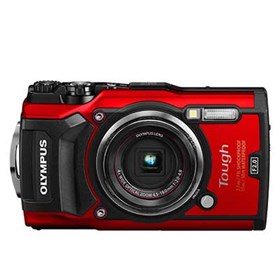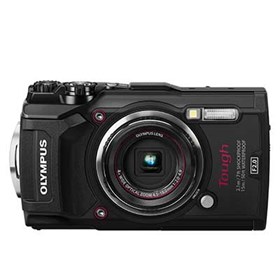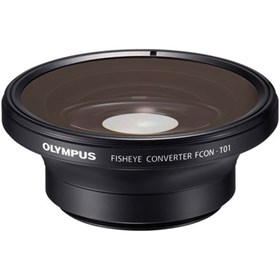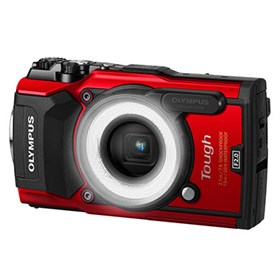Olympus’ Tough TG-5 is shockproof, crushproof, freezeproof and waterproof, but can it survive three days of extreme activities in the hands of two accident-prone journalists?

We took the TG-5 to the beautiful island of Gozo and carried it with us during a variety of extreme activities. Mike Harris
Millennia from now, when nearly all remnants of our immediate history have vanished, the future inhabitants of Earth will still be digging up original Game Boys, Nokia 3310s and Tough TG-5s. If the name hasn’t made things clear enough already, Olympus' little action camera can take a beating. And yet, our review of the TG-5 back in 2017 featured a series of delightful images such as people relaxing on deckchairs and somebody holding a delicious selection of bakes. In hindsight, it was a little like asking Chuck Norris to read a bedtime story.
So when Olympus offered to send both myself and our technical editor Amy Moore to Malta, we both jumped at the chance to take the Tough on a real adventure. We’d worry about the prospect of scaling a sheer rock face, kayaking out to sea and snorkelling alongside the odd jellyfish later…

The Olympus Tough TG-5 is shockproof, crushproof, freezeproof and waterproof.
What’s inside the TG-5?
The TG-5 is built around a 1/2.33in backside-illuminated CMOS sensor, like the TG-4. But, even though it sports a smaller (12MP) resolution, the TG-5 trumps its predecessor by housing the latest TruePic VIII processor. Olympus aficionados will recognise this as the same processor within the flagship OM-D E-M1 Mark II. The result is a camera that outperforms the TG-4 in terms of image quality.
The TG-5 also sports a 25-100mm (35mm equivalent) optical zoom and a maximum variable aperture of f/2 to 4.9. The camera boasts a very impressive minimum focus distance of 1cm and you’re able to retain as much information as possible from your files with the ability to shoot in RAW – it’s worth noting that the file format menu is accessed by holding down the Menu and Ok buttons simultaneously.

That 1cm minimum focus distance means you can get extremely close.
The TG-5 features an impressive array of photo modes, from the generic Aperture Priority and i-Auto to the more specialist Underwater, Microscope and Art Filter modes. Scene Modes in particular is very useful, featuring a variety of sub-modes for almost any shooting situation you can think of including Night Scene, Sports, Beach and Snow, and Landscape. The camera is also capable of processing a variety of relatively advanced editing techniques in-camera, with Panorama, Focus Stacking and several HDR modes.

A three-shot panorama from our mountain biking tour. Mike Harris
You’ve options for video too. The TG-5 can shoot 4K video at 30fps and Full HD at 60fps. There’s also a particularly impressive super slow-motion function, shooting Full HD at 120fps and HD at 240fps. If that wasn’t enough, on the top of the camera you’ll notice a small switch that is flanked by the words OFF and LOG. This is the TG-5’s comprehensive Field Sensor System, which is equipped with GPS, a temperature sensor, manometer and compass. This information can be paired with Olympus’ OI. Track app which can link movement, altitude and depth routes with images.
The field test
We know that the TG-5 is a very capable compact camera. Back in 2017, our reviewer said its image quality surpassed any other action camera he’d used. Our goal was to find out how this rugged little camera would perform on the equally rugged Island of Gozo in Malta. We reached Gozo following a short ferry ride from the mainland. Despite being under nine miles long and only around 4.5 miles wide, it’s the second largest island in the Maltese archipelago, and if you haven’t yet noticed, it’s simply stunning.
Upon our arrival at the Ulysses Aparthotel in Xlendi Bay, we were greeted by Gozo resident, Olympus enthusiast and award-winning underwater photographer Pete Bullen. Pete operates from his office at Moby Dives and offers guided tours of the island, alongside both underwater and land-based photography coaching. A quick browse of his website reveals the extent of his photographic prowess, and his knowledge of Gozo has to be unrivalled. Along with his irresistible canine companion Bob, Pete would be our guide for the duration of the trip.

The clear blue water that surrounds the island is a sight to behold. Amy Moore
Tough by name, tough by nature
During our time on the island, the TG-5 met with concrete, coral, sand, dust and rocks. And, aside from a few scratches to the rear LCD – nothing a screen protector wouldn’t fix – and the odd scuff, our TG-5 weathered everything we could throw at it. And believe me, it was literally thrown (unintentionally, of course). According to Olympus, the camera is shockproof up to 2.1m and crushproof up to 100kg, and I'm inclined to agree.
Beneath its hardened exterior, the TG-5 is a versatile little camera, as its specification suggests. The transition between snapping marine life and stepping out of the water to capture subjects on land is seamless. But, that’s far from the extent of its flexible functionality. You might find it surprising, but I reckon this rock-solid little compact camera could appeal to casual, amateur and professional photographers alike. Hear me out.
For the holidaymaker looking for a dedicated compact camera that can champion their smartphone and deliver an equally intuitive experience, the TG-5 is ideal. It can rattle around at the bottom of a rucksack, swing from a belt or dangle from the wrist and providing you don’t do something really stupid, it’s an item of technology you don’t really have to worry about (and that’s a rarity). Its versatility also makes it an ideal portal to some of the more challenging aspects of photography like focus stacking, HDR and the ability to really play around with images in post by shooting RAW.

Gozo isn’t just about beautiful scenery; some of the buildings are equally as stunning. Amy Moore
Just how much punishment the TG-5 can take, I couldn’t say because we didn’t break it, although that wasn’t for lack of trying. Our review sample was dropped from chest height onto concrete more times than I’d care to admit. It clipped jagged rocks while swinging from my harness as I (tentatively) climbed up a cliff. It was covered in sand and a momentary lack of judgement when snorkelling caused it to bounce off a piece of coral.
Olympus is never going to send us another review sample again…
While it’s foolish to suggest that anything is entirely kid-proof, the TG-5 is an ideal camera for families. I’d be more than happy to let a little one have fun with the Tough and would only feel the need to keep half an eye on a camera that can withstand being buried in sand and dropped to the bottom of a rock pool. However, would I recommend it to a pair of weedy journalists engaging in a series of terrifying activities? You’re about to find out.

The transition from water to land is seamless. I shot this immediately after my snorkelling session. Mike Harris
Snorkelling
Neither myself nor Amy had ever snorkelled before and as we tentatively wobbled our way towards the shallows and procrastinated in ankle-deep water, I couldn’t help but wonder what Pete (and Bob) were thinking. Now, I’m a relatively experienced swimmer, but I have an irrational fear of the sea. However, with my TG-5 in hand and the excitement of trying underwater photography for the very first time, I secured my snorkel and headed out into the water. I’m glad I did.

Fish are challenging subjects to shoot, especially when they assume you’re a predator. They also have an uncanny ability to blend into their environment. Mike Harris
Inches from the surface, I’d entered a world I had only ever seen in photos or on TV. After a few minutes of getting used to breathing steadily underwater, I started to play with the TG-5 that was tightly attached to my wrist. Pete had told me that many fish are very territorial and operate within a small patch. His advice was to select a subject, track its movement, envision the shot and wait for it to swim obliviously into the frame.
He also explained that a camera lens probably looks like a giant eye to the many small underwater inhabitants and I’d have more luck if I raised the camera at the last possible moment before taking the shot. This was particularly apparent during the short amount of time I spent with the FCON-T01 Fisheye Converter, which enables wide-angle shooting without sacrificing the brightness of the f/2 lens. We also spent some time with the small LG-1 Light Guide, which will evenly illuminate macro subjects.
Thankfully, the TG-5’s various underwater settings made it extremely easy to use. With the mode dial on the back of the camera set to the fish icon, you can use the D-pad to cycle through Underwater Snapshot, Underwater Wide, Underwater Macro and Underwater HDR. This intuitive system paired with the TG-5’s robustness meant I could focus most of my attention on what felt like the biggest challenge at the time, snorkelling.

This image illustrates how adapt octopi are at camouflage, I only happened upon this one by accident. Mike Harris
Not only did I enjoy using the TG-5 underwater, I’m certain it encouraged exploration and helped me to move beyond my fears, as I focused on taking photos. I’ve always felt that a camera can increase your confidence and the TG-5 did just that. I even managed to come away with a photo of an octopus, which was incidentally my last subject before getting out of the water. This is another area in which the TG-5 excels; you can simply exit the water, flick the mode dial and continue taking photos. And let’s not forget, the TG-5 is waterproof up to 15m (nearly 50ft), so it’s a camera that’s quite capable of being used by competent divers too.

We both thoroughly enjoyed our mountain biking session, there’s no better way to traverse the island. Pete Bullen
Mountain biking
For our next challenge we were met by three-time Masters Downhill World Champion, and European and British Champion in downhill mountain biking, Petra Wiltshire. Petra co-owns Cycle Gozo and runs electric bike (e-bike) tours around the island. An e-bike is very similar to a conventional mountain bike, although it carries a small electric motor, which can be activated to provide varying levels of assistance when pedalling.
The bikes proved the perfect way to see the island and with my TG-5 swinging from the chest strap on my backpack we set off. Once again, the camera’s rugged build proved hugely advantageous. Its resistance to both knocks and dust meant I wasn’t worried about housing it within a bag, which is hugely liberating. If I saw something I wanted to photograph I could simply hop off my bike, take a photo and set off again.

The TG-5 really excels as a scouting camera and I’d have no problem giving it a permanent slot in my kit bag. Pete Bullen
This is why I think the TG-5 could actually appeal to serious amateur photographers and professionals. It’s an ideal camera for scouting locations. I’m not suggesting it’ll be used as a professional’s main rig, but if you were to spend a week photographing a small location like Gozo and wanted to spend the first two or three days scouting locations, what would be the point of lugging around a hefty DSLR or still rather weighty CSC that are both expensive and breakable?
Even with help from our e-bikes, exploring the island with no shade and traversing some rather tricky obstacles proved hard work. Several times I undid my chest strap without thinking and haplessly watched the TG-5 plummet onto hard concrete, which it shrugged off like it was nothing. The stunning coastal scenery provided the perfect opportunity to take some photos and make use of the TG-5’s panorama mode. You’ll even find an attitude indicator which displays the cameras pitch and roll in real-time on the rear LCD, making it easier to line up that perfect horizon.

Kayaking and paddleboarding are popular pastimes on the island, and with deep blue water and breathtaking coastal scenery, it’s easy to see why. Mike Harris
Kayaking
Having looked forward to the mountain biking, sea kayaking was another activity we were both slightly nervous about. However, once we’d realised that upturned kayaks are something of a myth (it really doesn’t happen very often), we happily paddled into a number of sea caves and then across to the nearby island of Comino.
Using any camera in such conditions is challenging. A kayak will remain surprisingly stable so long as your head and body is centred. However, when stuck in a difficult to manoeuvre vessel (at least for beginners) you have a tendency to lean out of the boat to frame your shot and this is precisely the conditions in which you start to tip. Another problem with taking photos from a kayak is that the oar gets in the way. Not only does it have a tendency to sneak into the frame, but whether you’re holding it in one hand or resting it across your kayak, it’s just something else to think about.

I found turning my kayak particularly difficult, which made photography very difficult indeed. At least I didn’t have to worry about getting the TG-5 wet. Mike Harris

A JPEG shot from within a cave. The tight walls allowed me to centre my boat with one hand and quickly take a shot with the other. Mike Harris
Yet again, the TG-5’s robustness championed this situation. I had it attached to a strap on my lifejacket and had I upturned, I knew I wouldn’t have to worry about the camera at all. I also didn’t have to worry about bashing it against the kayak. When the vessel starts to tip, your immediate reaction is to ditch the camera, grab the oar and centre your head and body. The TG-5 bounced off the hard plastic shell of my kayak countless times, but I knew it could take it.
Our return journey to Gozo proved slightly choppier than expected, but with our expert kayaking instructor Michael from Gozo Adventures, we were in good hands (we certainly couldn’t have found a better or more chilled out mentor).

My mind couldn’t have been farther from the TG-5 dangling from my harness. Pete Bullen (shot on OM-D EM-1 Mark II)
Climbing
We were reunited with Gozo Adventures for our final activity and enjoyed our morning spent with our climbing instructor Didi, whose dry sense of humour calmed any nerves! It was in fact Didi who originally scouted and secured all of the climbing routes himself, so he knew every single inch of rock like the back of his hand.
We both thoroughly enjoyed photographing each other as we made our ascents, but I also clipped the TG-5 to my harness to see how it fared bouncing off rocks as it swung from my hip. Once again, it shrugged off each and every impact like it was nothing.

Gozo is littered with photographic opportunities and we were always asking Pete to stop his truck so we could take some shots and enjoy the views. Mike Harris
After the climbing we still had one last task left to complete, which actually involved testing Olympus’ flagship CSC, the OM-D EM-1 Mark II. We headed out around midnight to use the camera for some astrophotography and even then the TG-5 made an appearance. We wanted to face towards the North Star so we could shoot some star trails, which we found using the TG-5’s compass. This is a perfect illustration of what a great accessory the Tough is, even if it plays second or third fiddle to your bigger cameras.

A last shot of the island before the return ferry ride back to the mainland. I think we both want to visit the island again very soon! Mike Harris
Conclusion
Whether you’re looking for an easy-to-use compact that you can clip to your belt and not worry about, or a hardy camera for scouting locations, I can heartily recommend the Tough. It’s an ideal companion for the adrenaline junky or an outdoorsy adventurer and will even serve as a family camera that’ll weather the rigours of tiny hands. As for Gozo, I know both myself and Amy are eager to return and we might just ensure there’s room for a TG-5 in our kit bags too.
About the Author
Mike Harris is Wex Photo Video’s production editor and is an experienced journalist with a passion for motorsport photography. You can view his portfolio via @MDHarrisPhoto on Instagram.

Olympus Stylus Tough TG-5 Digital Camera - Red

Olympus Stylus Tough TG-5 Digital Camera - Black

Olympus FCON-T01 Fisheye Converter




